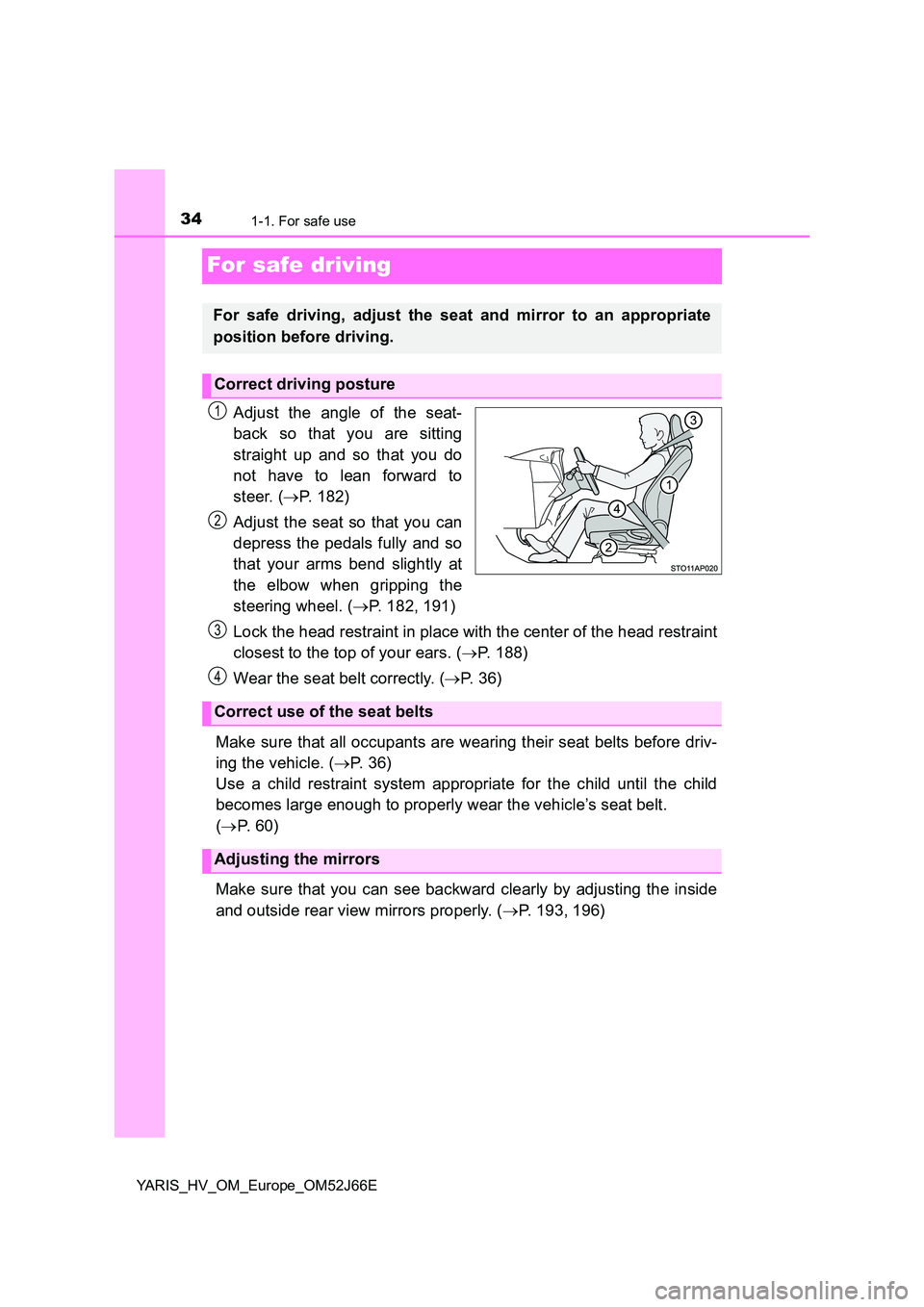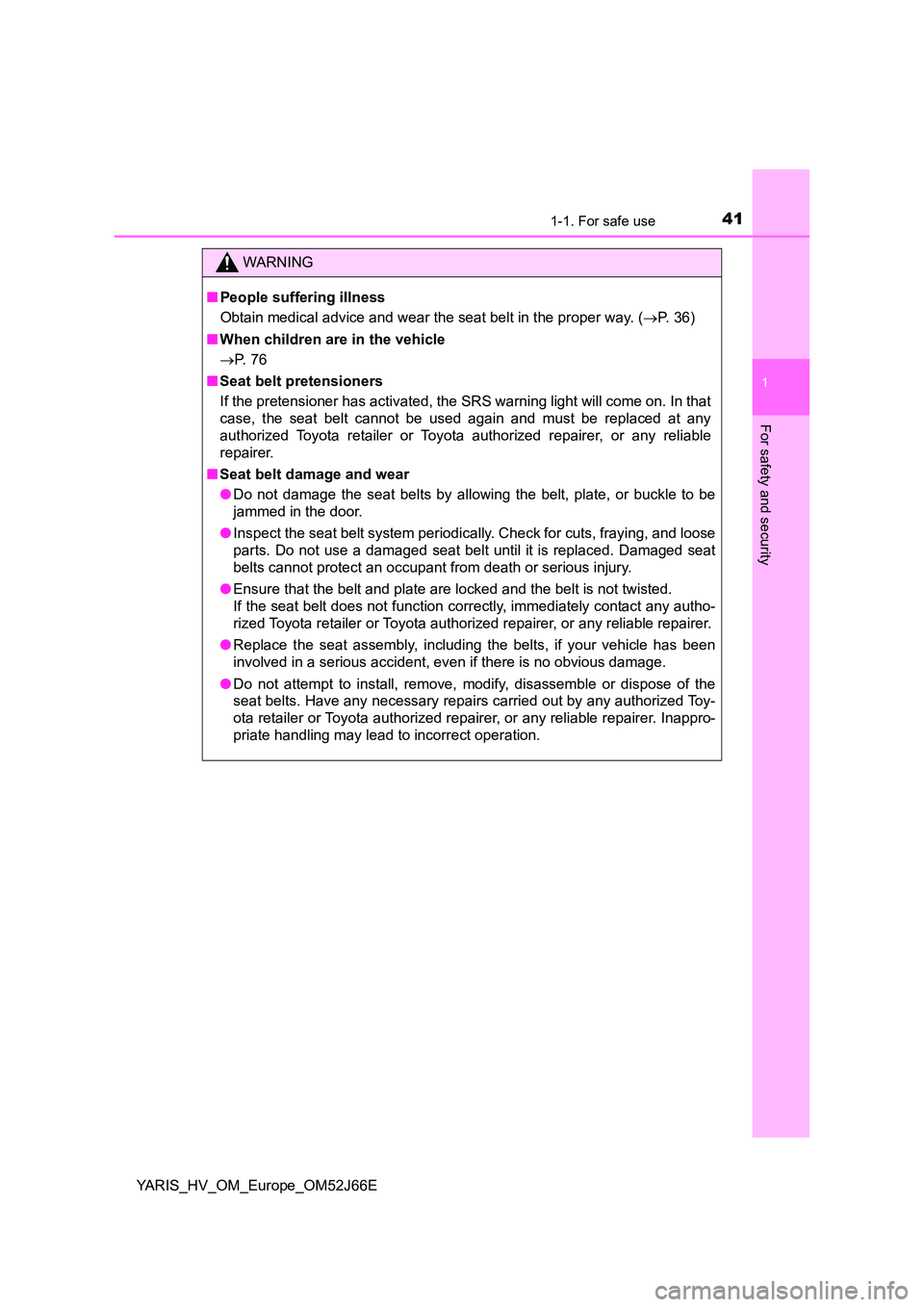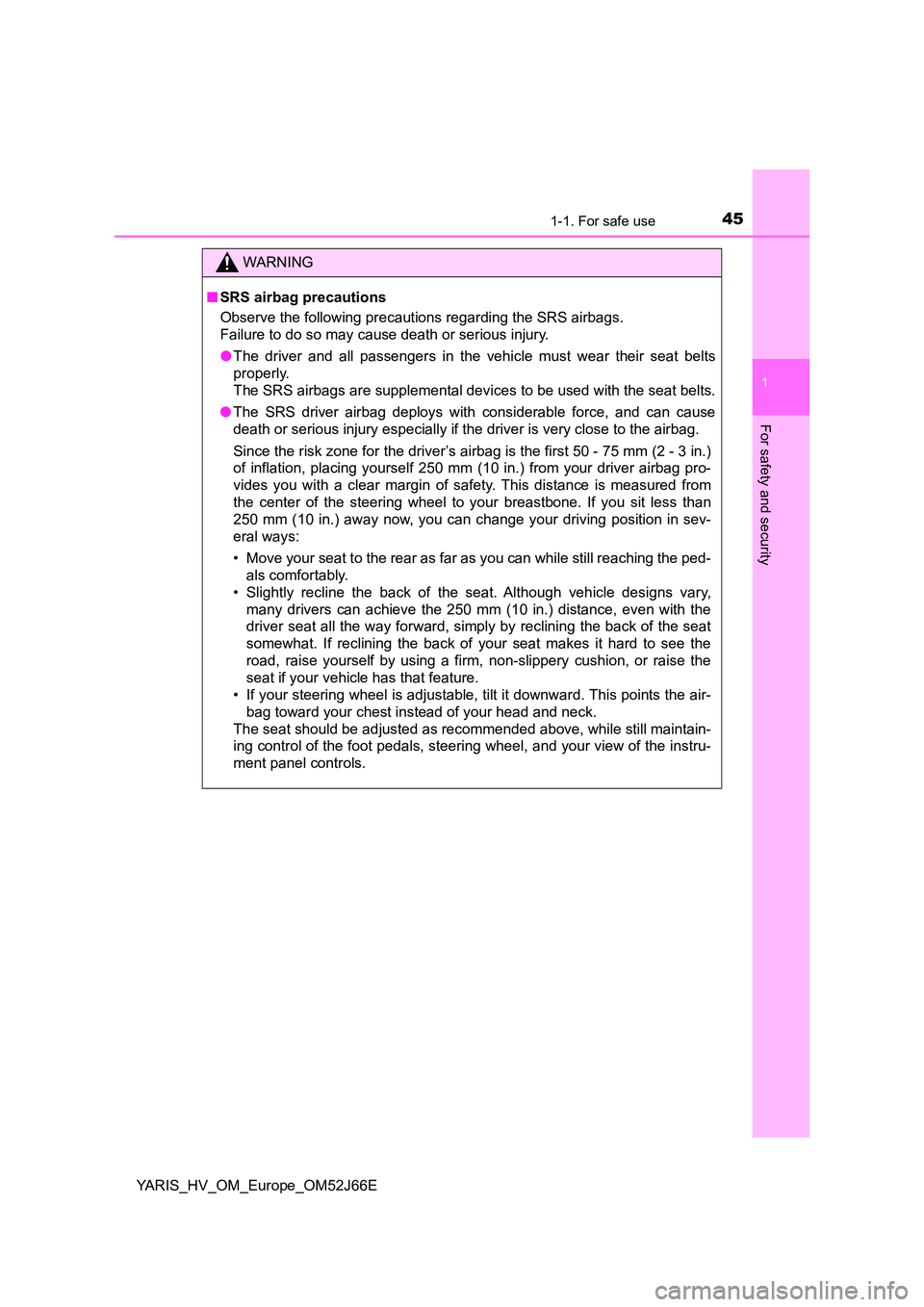Page 34 of 632

341-1. For safe use
YARIS_HV_OM_Europe_OM52J66E
For safe driving
Adjust the angle of the seat-
back so that you are sitting
straight up and so that you do
not have to lean forward to
steer. ( P. 182)
Adjust the seat so that you can
depress the pedals fully and so
that your arms bend slightly at
the elbow when gripping the
steering wheel. ( P. 182, 191)
Lock the head restraint in place with the center of the head restraint
closest to the top of your ears. ( P. 188)
Wear the seat belt correctly. ( P. 3 6 )
Make sure that all occupants are wearing their seat belts before driv-
ing the vehicle. ( P. 3 6 )
Use a child restraint system appropriate for the child until the child
becomes large enough to properly wear the vehicle’s seat belt.
( P. 6 0 )
Make sure that you can see backward clearly by adjusting the inside
and outside rear view mirrors properly. ( P. 193, 196)
For safe driving, adjust the seat and mirror to an appropriate
position before driving.
Correct driving posture
1
2
Correct use of the seat belts
Adjusting the mirrors
3
4
Page 41 of 632

411-1. For safe use
1
For safety and security
YARIS_HV_OM_Europe_OM52J66E
WARNING
■People suffering illness
Obtain medical advice and wear the seat belt in the proper way. ( P. 36)
■ When children are in the vehicle
P. 7 6
■ Seat belt pretensioners
If the pretensioner has activated, the SRS warning light will come on. In that
case, the seat belt cannot be used again and must be replaced at any
authorized Toyota retailer or Toyota authorized repairer, or any reliable
repairer.
■ Seat belt damage and wear
● Do not damage the seat belts by allowing the belt, plate, or buckle to be
jammed in the door.
● Inspect the seat belt system periodically. Check for cuts, fraying, and loose
parts. Do not use a damaged seat belt until it is replaced. Damaged seat
belts cannot protect an occupant from death or serious injury.
● Ensure that the belt and plate are locked and the belt is not twisted.
If the seat belt does not function correctly, immediately contact any autho-
rized Toyota retailer or Toyota authorized repairer, or any reliable repairer.
● Replace the seat assembly, including the belts, if your vehicle has been
involved in a serious accident, even if there is no obvious damage.
● Do not attempt to install, remove, modify, disassemble or dispose of the
seat belts. Have any necessary repairs carried out by any authorized Toy-
ota retailer or Toyota authorized repairer, or any reliable repairer. Inappro-
priate handling may lead to incorrect operation.
Page 44 of 632
441-1. For safe use
YARIS_HV_OM_Europe_OM52J66E
*: If equipped
The main SRS airbag system components are shown above. The
SRS airbag system is controlled by the airbag sensor assembly. As
the airbags deploy, a chemical reaction in the inflators quickly fills the
airbags with non-toxic gas to help restrain the motion of the occu-
pants.
SRS airbag system components
Seat belt pretensioners and
force limiters (front seats)
Side impact sensors (front)
Side airbags
Curtain shield airbags*
Seat belt pretensioners and
force limiters (rear outboard
seats)
Side impact sensors (rear)*
Side impact sensors (front
door)*
Driver airbag
SRS warning light
Driver knee airbag*
Airbag sensor assembly
Front impact sensor
Airbag manual on-off switch
Front passenger airbag
“PASSENGER AIR BAG” indi-
cator
1
2
3
4
5
6
7
8
9
10
11
12
13
14
15
Page 45 of 632

451-1. For safe use
1
For safety and security
YARIS_HV_OM_Europe_OM52J66E
WARNING
■SRS airbag precautions
Observe the following precautions regarding the SRS airbags.
Failure to do so may cause death or serious injury.
● The driver and all passengers in the vehicle must wear their seat belts
properly.
The SRS airbags are supplemental devic es to be used with the seat belts.
● The SRS driver airbag deploys with considerable force, and can cause
death or serious injury especially if the driver is very close to the airbag.
Since the risk zone for the driver’s airbag is the first 50 - 75 mm (2 - 3 in.)
of inflation, placing yourself 250 mm ( 10 in.) from your driver airbag pro-
vides you with a clear margin of safety. This distance is measured from
the center of the steering wheel to your breastbone. If you sit less than
250 mm (10 in.) away now, you can change your driving position in sev-
eral ways:
• Move your seat to the rear as far as you can while still reaching the ped-
als comfortably.
• Slightly recline the back of the seat. Although vehicle designs vary,
many drivers can achieve the 250 mm (10 in.) distance, even with the
driver seat all the way forward, simply by reclining the back of the seat
somewhat. If reclining the back of your seat makes it hard to see the
road, raise yourself by using a firm, non-slippery cushion, or raise the
seat if your vehicle has that feature.
• If your steering wheel is adjustable, tilt it downward. This points the air-
bag toward your chest instead of your head and neck.
The seat should be adjusted as recommended above, while still maintain-
ing control of the foot pedals, steering wheel, and your view of the instru-
ment panel controls.
Page 50 of 632

501-1. For safe use
YARIS_HV_OM_Europe_OM52J66E
■If the SRS airbags deploy (inflate)
● Slight abrasions, burns, bruising, etc., may be sustained from SRS airbags,
due to the extremely high speed deployment (inflation) by hot gases.
● A loud noise and white powder will be emitted.
● Vehicles without SRS curtain shield airbags: Parts of the airbag module
(steering wheel hub, airbag cover and inflator) as well as the front seats may
be hot for several minutes. The airbag itself may also be hot.
● Vehicles with SRS curtain shield airbags: Parts of the airbag module (steer-
ing wheel hub, airbag cover and inflator) as well as the front seats, parts of
the front and rear pillars, and roof side rails, may be hot for several minutes.
The airbag itself may also be hot.
● The windshield may crack.
■ SRS airbag deployment conditions (SRS front airbags)
● The SRS front airbags will deploy in the event of an impact that exceeds the
set threshold level (the level of force corresponding to an approximately
20 - 30 km/h [12 - 18 mph] frontal collision with a fixed wall that does not
move or deform).
However, this threshold velocity will be considerably higher in the following
situations:
• If the vehicle strikes an object, such as a parked vehicle or sign pole,
which can move or deform on impact
• If the vehicle is involved in an underride collision, such as a collision in
which the front of the vehicle “underrides”, or goes under, the bed of a
truck
● Depending on the type of collision, it is possible that only the seat belt pre-
tensioners will activate.
Page 55 of 632

551-1. For safe use
1
For safety and security
YARIS_HV_OM_Europe_OM52J66E
Exhaust gas precautions
Harmful substance to the human body is included in exhaust
gases if inhale.
WARNING
Exhaust gases include harmful carbon monoxide (CO), which is colorless and
odorless. Observe the following precautions.
Failure to do so may cause exhaust gases enter the vehicle and may lead to
an accident caused by light-headedness, or may lead to death or a serious
health hazard.
■ Important points while driving
● Keep the back door closed.
● If you smell exhaust gases in the vehicle even when the back door is
closed, open the windows and have the vehicle inspected at any autho-
rized Toyota retailer or Toyota authorized repairer, or any reliable repairer
as soon as possible.
■ When parking
● If the vehicle is in a poorly ventilated area or a closed area, such as a
garage, stop the hybrid system.
● Do not leave the vehicle with the hybrid system operating for a long time.
If such a situation cannot be avoided, park the vehicle in an open space
and ensure that exhaust fumes do not enter the vehicle interior.
● Do not leave the hybrid system operating in an area with snow build-up, or
where it is snowing. If snowbanks build up around the vehicle while the
hybrid system is operating, exhaust gases may collect and enter the vehi-
cle.
■ Exhaust pipe
The exhaust system needs to be checked periodically. If there is a hole or
crack caused by corrosion, damage to a joint or abnormal exhaust noise, be
sure to have the vehicle inspected and repaired by any authorized Toyota
retailer or Toyota authorized repairer, or any reliable repairer.
Page 56 of 632
561-2. Child safety
YARIS_HV_OM_Europe_OM52J66E
Airbag manual on-off system
“PASSENGER AIR BAG” indi-
cator
Vehicles without a smart entry &
start system
The “ON” indicator light turns on
when the airbag system is on (only
when the power switch is in the
“ON” position).
Vehicles with a smart entry &
start system
The “ON” indicator light turns on
when the airbag system is on (only
when the power switch is in ON
mode).
Airbag manual on-off switch
This system deactivates the front passenger airbag.
Only deactivate the airbags when using a child restraint system
on the front passenger seat.
1
2
Page 57 of 632
571-2. Child safety
1
For safety and security
YARIS_HV_OM_Europe_OM52J66E
Vehicles without a smart entry
& start system
Insert the key into the cylinder and
turn to the “OFF” position.
The “OFF” indicator light turns on
(only when the power switch is in
the “ON” position).
Vehicles with a smart entry &
start system
Insert the mechanical key into the cylinder and rotate to the “OFF”
position.
The “OFF” indicator light turns on (only when the power switch is in ON
mode).
■ “PASSENGER AIR BAG” indicator information
If any of the following problems occur, it is possible that there is a malfunction
in the system. Have the vehicle inspected by any authorized Toyota retailer or
Toyota authorized repairer, or any reliable repairer.
● Neither “ON” nor “OFF” comes on.
● The indicator light does not change when the airbag manual on-off switch is
switched to “ON” or “OFF”.
Deactivating the airbags for the front passenger